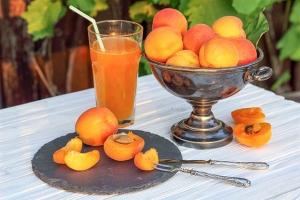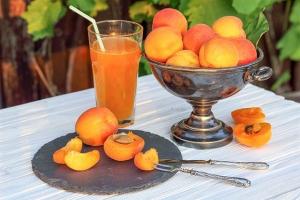To understand why a brewer needs a hydrometer, let's delve into the concept of wort gravity.
We measure the density of the wort
In short, wort is an aqueous hopped extract of beer malt. It is from the initial and final density beer wort depends on the strength of the beer. To determine the density of the wort, a special device called a hydrometer is used.
The hydrometer is immersed in a container (measuring cylinder or test tube) with beer wort before it ferments, we look at the hydrometer readings and record, we get the initial density of the wort. We repeat the measurement process after the wort has fermented, thereby knowing the final gravity of the wort. Now we are ready to calculate the strength of the beer, or rather the alcohol content per volume.
Calculate the strength of beer
Knowing the initial density of the beer wort before putting it on fermentation and the final density of the wort after fermentation, you can calculate the strength of the beer. Alcohol is defined as the difference between the alcohol corresponding to the initial gravity of the wort and the alcohol corresponding to the final gravity of the wort. As a result, we get the following formula:
Alc(%)=Alc(P1)-Alc(P2).
For example, the density of the wort during fermentation was 9.85%, which corresponds to an alcohol of 4.75%, and after fermentation, the density of the wort was 3%, which corresponds to an alcohol of 1.25%. We get: Alc(%)=4.75-1.25=3.5% - final alcohol content per volume.
STOP! After the beer has fermented, we add sugar syrup to it and leave it to ferment for a natural carbonation process. And this means that the beer after carbonation will become a little stronger. To take into account this error, we will add another 0.4-0.5% to the final alcohol content per volume. As a result, the alcohol content Alc(%)=3.5%+0.5%=4%
Now I think everyone understands that a hydrometer is simply a necessary thing for any brewer, both beginner and "experienced".
Below I have given a table of correspondence between the density of beer and alcohol, you can also calculate the final alcohol content using the calculator on the site.
Table of beer density and alcohol correspondence
| Alcohol, % | Density by hydrometer | Alcohol, % | Density by hydrometer | Density by hydrometer grew. scale, % | ||
|---|---|---|---|---|---|---|
| 0,00 | 1,002 | 0,50 | 7,50 | 1,060 | 15,00 | |
| 0,25 | 1,004 | 1,00 | 7,75 | 1,061 | 15,38 | |
| 0,50 | 1,006 | 1,50 | 8,00 | 1,063 | 15,75 | |
| 0,75 | 1,008 | 2,00 | 8,25 | 1,065 | 16,25 | |
| 1,00 | 1,010 | 2,50 | 8,50 | 1,067 | 16,75 | |
| 1,25 | 1,012 | 3,00 | 8,75 | 1,069 | 17,25 | |
| 1,50 | 1,014 | 3,50 | 9,00 | 1,071 | 17,75 | |
| 1,75 | 1,016 | 4,00 | 9,25 | 1,073 | 18,25 | |
| 2,00 | 1,018 | 4,50 | 9,50 | 1,075 | 18,75 | |
| 2,25 | 1,020 | 5,00 | 9,75 | 1,076 | 19,13 | |
| 2,50 | 1,022 | 5,50 | 10,00 | 1,078 | 19,50 | |
| 2,75 | 1,024 | 6,00 | 10,25 | 1,080 | 20,00 | |
| 3,00 | 1,026 | 6,50 | 10,50 | 1,082 | 20,50 | |
| 3,25 | 1,028 | 7,00 | 10,75 | 1,084 | 21,00 | |
| 3,50 | 1,030 | 7,50 | 11,00 | 1,086 | 21,50 | |
| 3,75 | 1,032 | 8,00 | 11,25 | 1,088 | 22,00 | |
| 4,00 | 1,034 | 8,50 | 11,50 | 1,090 | 22,50 | |
| 4,25 | 1,036 | 9,00 | 11,75 | 1,092 | 23,13 | |
| 4,50 | 1,038 | 9,50 | 12,00 | 1,093 | 23,25 | |
| 4,75 | 1,040 | 9,88 | 12,25 | 1,095 | 23,75 | |
| 5,00 | 1,041 | 10,25 | 12,50 | 1,097 | 24,25 | |
| 5,25 | 1,043 | 10,75 | 12,75 | 1,098 | 24,50 | |
| 5,50 | 1,045 | 11,25 | 13,00 | 1,100 | 25,00 | |
| 5,75 | 1,047 | 11,75 | 13,25 | 1,100 | 25,50 | |
| 6,00 | 1,049 | 12,25 | 13,50 | 1,104 | 26,00 | |
| 6,25 | 1,051 | 12,75 | 13,75 | 1,105 | 26,25 | |
| 6,50 | 1,053 | 13,25 | 14,00 | 1,107 | 26,75 | |
| 6,75 | 1,055 | 13,38 | 14,25 | 1,109 | 27,25 | |
| 7,00 | 1,056 | 14,00 | 14,50 | 1,111 | 27,75 | |
| 7,25 | 1,058 | 14,50 | 14,75 | 1,113 | 28,25 |
Now, having a comparison table at hand, you can fully control the brewing process, knowing what you will get as a result. If you decide to take the brewing process seriously, I recommend downloading and printing the table so that it is always in front of your eyes.
In future articles, when we will consider the brewing process step by step, I will describe how you can influence the strength of beer, although I think you have already guessed it yourself.
Good luck with your fermentation process!
3532
2
Density
The density of beer is measured as the density of any other liquid relative to the density of water. The density of distilled water at 150°C is taken as 1.000. Moreover, the decimal point when measuring the density of beer is usually omitted. The density of beer is measured before fermentation (fermentation). This density is usually called the initial density (OG - Original Gravity or SG - Starting Gravity). Usually the initial gravity, depending on the variety, varies from 1020 to 1160. The density after brewing beer is called final density(FG - Final Gravity or TG - Terminal Gravity). This method of measuring the density of beer is used mainly in England. To obtain gravity values accepted in Europe, the initial gravity of the beer, discarding the highest unit, should be divided by four. That is, a beer with a density of 1045 according to the English system has a density of 11% (degrees Plato) according to the European system.
Fortress
The strength of beer is primarily the alcohol content. In most countries, the fortress is measured as a percentage of the volume (abv - alcohol by volume). In the US, alcohol is measured as a percentage of weight (alcohol by weight), which generally gives a difference in measurement of about 20%. For example: 5% abv equals 4% abw. An approximate estimate of the strength can be given, knowing the initial gravity of the beer. For the English system, the initial gravity, discarding the highest unit, must be divided by ten, that is, a beer with a gravity of 1045 will have approximately 4.5% alcohol by volume. for the European system, you need to divide the number of degrees of the Plateau by 2.5.
What are the types of beer
(international definitions)
Here is an explanation of the commonly accepted international definitions of beer categories. The above nomenclature is the base for tastings. We do not provide strict technical specifications, such as IBU (international bitterness units) and the like, although they are used quite widely in international practice.
International Pale Lager - Pilsner Beer
Before 1342, all beers were dark or hazy. This year, the newly built brewery in Pilsen, Bohemia, produced a golden and clear beer for the first time in the world. This brewery is today's Pilsner Urguell located in the Czech Republic. The variety quickly gained popularity in other beer-producing countries as well, with the best beers being low to medium in strength and highly carbonated. Traditional Czech hops give the beer an extraordinary invigorating ability and light bitterness. Even heavily chilled, these beers still remain tender, and in order to show their best qualities these varieties must be fresh. Pale lager is the standard international beer style, from Miller to Heineken. At first, lagers were a bland interpretation of Pilsner beer, but even today, the differences between the two are often vague. They are usually less strong as they contain more gentle hops and are uplifting in character. In fact, these styles are fairly close in trend and thus should be tasting in the same category. Traditionally this category cannot include related varieties such as Dortmunder and Munich Hidles.
International dark lagers
These beers, while being the original lagers, are today the forerunners of pale lagers. Their homeland is Bavaria and the areas around it, but today these varieties are widely produced both in Bavaria and around the world. this is often all the average consumer knows when they think of dark beers. The best varieties of these beers combine the features of a dryish chocolate or liquor along with the use of dark malts and the intolerance and invigorating properties of a lager. Brewed in and around Munich, these beers are slightly higher in strength and sometimes have a sweetness to the palate. This category has a narrower definition of "international style", so dark lagers such as Doppelbock and Swarzhier are not included.
pale ale
Perhaps most easily identified in relation to a related style, bitter beer. At first, this quality was a property of English varieties. Usually Bitter beer is the standard type of beer produced by British breweries. Typically, these beers are characterized by moderate strength and a distinct bitter note, which is given by a certain accent of hops. These varieties range in color from amber to copper, some breweries produce several different maximum strength bitters called "Extra Special Bitter" (ESB). This species is now widely distributed in North America. Pale ale varieties are usually close to bitter beer styles and often where bitter beer ends and pale ale begins is determined based on individual perceptions. Pale ales tend to be stronger and have a more pronounced mouthfeel on the palate. In Britain, these varieties are usually bottled rather than strained or pumped by hand. Many examples have an intense fruity aroma that can be quite seductive. Despite their name, the ales are not pale, but have more than an amber hue. The original name referred to this type of beer, which was lighter in color than the brown and black beers that had aged at the time of its production. Pale ales are more widely exported than bitters.
Porter
First brewed in London in the early 1700s. Porter's original name is a matter of debate, however the beer itself was intended to combine the properties of several beers that were popular at the time. Thus, it was the first type of beer to gain national popularity in the British Isles. Heavily roasted, but not as strong as a stout, they often have a bitter, slightly sour note. In the 1700s in London, this variety was first obtained by oxidation (the process by which alcohol is converted into vinegar). in order to achieve this effect when storing beer in barrels, it often takes years. The high cost of porter has led to it being often served watered down with fresh beer. this style actually died out in 1973, but in the wake of its renewed popularity, a new generation of brewers began to revive it. Because of this, as well as differing opinions about what constituted a "true porter", different brewers have different variations depending on their interpretation. However, porters are of particular interest to Russia, since similar varieties were produced in the Baltic Republics and are still produced there today.
dry stout
A category that is closely associated with Ireland and especially with Guinness. These beers are very dark, almost black, and have a strong roasted aroma profile and varying notes of bitterness. This is achieved by using malt for brewing, which is dried in an oven until it resembles a burnt slice of bread. These beers are also typically brewed with the same classic top-fermenting yeast used to make ales, resulting in a fruity overtone. These varieties are classically served with oysters, although any Irish Stout drinker will tell you that a pint of beer is a meal in itself. Barreled Irish Stout is washed with nitrogen to give an extraordinary white creamy head. This process can now be carried out in both cans and bottles using a nitrogen “trick”. This type, soft, allowing you to drink in large sips, has spread widely throughout the world. Related beers are Sweet Stout (Milch), Oatmeal Stout and English Stout.
Hefeweizen
Weizenbier (or "Weiss" bier in English) comes from Southern Germany, specifically Bavaria, and uses at least 50% wheat in its brewing. Weizen beer does not undergo the intensive processing typical of a lager. Often these varieties are secondary fermentation in bottles, and yeast cultures used for this purpose can impart a spicy, clove-like flavor. Hefe, the German word for yeast, on the label indicates that there is yeast sediment in the bottle. Related beers are Dunkel (dark) and Kristall (clear, no yeast).
The ideal temperature for beer
About what temperature is considered ideal for beer, they argue all over the world. The Americans and Austrians believe that beer should be kept at freezing temperature, the British at room temperature (or even body temperature), and the rest of the world hovers somewhere in between. In Germany, the ideal temperature is 7-9. Beer should not be quickly cooled or heated, as this spoils its taste. If the beer is cloudy, the storage temperature was too low. In this case, put the beer in a warm place for a few minutes before drinking, and the turbidity will disappear. If the beer is very cold, it will not form an appropriate head. If the beer is very warm, it will form too much foam, and besides, it will have a delicate taste.
How to properly bottle beer
First, rinse the glass with cold water - this will cool it to a temperature close to the temperature of the beer. Alt and Koelsh can be poured in one step, but Pils requires a certain sequence of actions: first, the beer is poured at an angle until the foam reaches the rim of the glass, while it should be half full. If there is too much foam, place the glass for a few minutes until some of the foam settles. Then continue to pour the beer, holding the glass upright, until it is filled to the line and a head of foam forms. WEISSEN beer is poured even more slowly, as it is more frothy.
Glasses for beer
Glasses should be thoroughly degreased and rinsed with cold water before use. First, the glass is filled very quickly to half, holding it at an angle so that a minimum amount of foam forms, then the remaining beer is slowly poured into a vertically standing glass until a head of foam forms. The exception is Weizen beer: the beer from the bottle is poured slowly into the glass. Draft beer (from kegs) is a real pleasure, but you need to pay attention to the following: if the insulating gasket is separate from the tap, you must first install it and only then insert and install the closed tap. but even in this case, the glasses must be degreased and rinsed with cold water before use. After that, they are filled very slowly and carefully, since the pressure is quite high. First, beer is poured into an angled glass until the foam reaches the rim, then the glass is set aside for a while until some of the foam settles, and then filling continues. To ensure easy filling and the appearance of the correct cap, the beer is poured into the appropriate glasses for each type, the shape of which has been honed over many years. Pils, for example, are drunk from relatively small (300-500 ml) tulip-shaped glasses. Alt and Koelsh - from thin cylindrical glasses (200 ml). Weissbier - from very tall half-liter glasses shaped like a pipe, and Bavar an Pale - from huge liter mugs.
Created on 04/06/2019 01:52
On the beer label, the manufacturer lists the main characteristics of the drink - the volume, alcohol content and gravity of the beer. The last words are not clear to everyone: what does this characteristic mean and what does it affect?
Czech cuisine in St. Petersburg is inconceivable without beer, and beer is unthinkable without many recipes and various tastes. When choosing foamy, we focus on the variety, strength, method of preparation, less often - on compatibility with dishes that are offered as snacks. Only true connoisseurs pay attention to the initial density (wort extract) of beer. And not in vain. It directly affects the saturation of the drink, its taste and strength.
What affects the density of beer?
The initial and final gravity of beer is the amount of solids in the wort. The less the wort is diluted with water, the higher its density and the brighter the taste. The density of wheat beer is measured in percent or degrees Balling, and the numbers on the label indicate the weight of the extract in 100 grams of solution.
Gravity and alcohol in beer are two different things. The density is usually 2.5 times higher than alcohol degrees. However, these indicators do not have a direct relationship with each other, the density affects taste more than strength. For non-alcoholic beer, this figure is not higher than 5%, for light varieties and lager - 11-13%, for dark varieties it reaches 20%. Varieties with low and medium density combine lightness and fullness of taste. They are very refreshing. More dense grades have saturated, bright taste which reveals gradually.
How to determine the density of beer
In order to find out what density is in beer, use a hydrometer or hydrometer. The first is popular in Europe, the USA and Russia. In England and the countries on which she has traditionally had a great influence, a hydrometer is used. The device is immersed in a container with beer wort before and after fermentation and the final and initial density is obtained. During fermentation, it gradually decreases, and by the end of the process, the hydrometer shows about 2%.
There are many varieties of beer, and something new is added every year: the producers are on the alert. Since consumers have different preferences, in many variations.
Some drink only what is stronger, others like softer. We are sure that the taste and smell of foam for the most part depends only on how much alcohol it contains and what kind of malt was used for preparation.
In fact, the density and strength of beer are important - that is, not one, but two characteristics. Is there an interdependence between them?
Any brewer will tell you that gravity is one of the most important qualities of foam. This term refers to the density of the wort taken as a basis. This value is measured before it starts and at the moment when it ends.
Strictly speaking, the concept of "density" means the amount (weight) of the extract in 100 g of the solution prepared for fermentation. On the bottle, this indicator can be seen in Balling degrees or as a percentage.
What does it affect?
It would seem that the value of this indicator is so important? But let's think: the higher the density, the more saturated the taste of the drink should be and the brighter the aroma. This is quite logical and true.
Weak, too “diluted” beer is rated by beer lovers as watery, tasteless, devoid of an attractive smell.
The hydrometer will help us
If you decide to cook foam yourself, you can adjust this indicator at your own discretion.
Is there some more hydrometer- a device similar to a hydrometer. It is used mainly in England, while the hydrometer is popular in Russia, France, the United States and other countries.
This is just a small extract from the table. Brewers use it because it gives ready-made values that allow you to calculate the final gravity and strength of the resulting drink.
The densest
The maximum that this indicator can be is - 30% . In order to determine what the indicator is equal to at any particular moment of production, the winemaker must, starting from the 5-6th day from the start of fermentation, measure the final gravity. If the indicator does not change significantly for two days in a row, then the drink is ready - fermentation is over.
If the taste is perceived as watery, the fermentation process can be continued by adding must.
Beer and water
Determining the value of the indicator of interest to us, manufacturers based on the density of water. Conventionally, this value is considered to be unity. Before the start of fermentation, the specific gravity of the must is higher, then, after fermentation, it decreases.
The decline after fermentation reflects the amount of glucose converted to alcohol.

Fortress
Foam lovers, studying the label, pay attention to the fortress much more often than to the indicator described above.
How many degrees can be in beer?
Intoxicated is considered a low-alcohol drink, although some varieties refute this statement. But these varieties are made only with the help of certain tricks, for example, adding champagne yeast to the wort. Such beer can even reach 30% in terms of alcohol content.
Normally, if the manufacturer uses traditional technologies, the drink turns out to be 3-5 degrees. That is, the quantity ethyl alcohol, released after the fermentation of the wort, will be equal to 3-5, sometimes 6 percent of the total volume.
The strongest beer brewed traditional recipe, that is, only using hops, malt and water, can reach 14% ABV.
What determines the strength of beer?
There is no single factor that would determine the exact alcohol content of a finished drink. Everything is important:
- which one was used;
- how much must was taken;
- what type of fermentation was used.
There are two types of fermentation:
- Grassroots.
- Horse.
 The first type is also called camp. In this case, the entire cooking process takes place at sufficiently low temperatures - from 4 to 9ºС.
The first type is also called camp. In this case, the entire cooking process takes place at sufficiently low temperatures - from 4 to 9ºС.
Such a drink turns out to be stronger, the alcohol content in percentage terms is up to 5.
Top fermentation allows you to get a richer and more aromatic drink. However, its taste may be heterogeneous.
This technology involves heating the wort up to 25ºС. The method is ancient, known to people from time immemorial. This is how ale and porter are made.
Some believe that light varieties are weaker in relation to the alcohol component. However, this is not the case: a lighter one may well turn out to be slightly less intoxicating than a young wine, or even equal to it.
How to determine degree?
On the label of the bottle with the finished drink, the strength is indicated: perhaps this is a value equal to 3.5, maybe 5, or maybe 12.
If you yourself are engaged in home production, pay attention to the density: usually this figure is 2.5 times higher than the fortress. Therefore, by measuring with a hydrometer at the end of fermentation, you will have an idea of how much alcohol will be in the finished product.
The lightest
The lowest alcohol content in hops is 2.5%. If you decide to buy something light, pay attention to Nevsky Light or Miller. These varieties contain about 3.2% alcohol.
The strongest
Want something more substantial? We can recommend our Baltika No. 9. In general, the Scots produced the strongest beer, their Brewmeister reached 67.5% abv! Of course, there were tricks here - for example, the same champagne yeast or some other additives.
How to increase the degree?
Do you make homemade beer? To make it completely different from its non-alcoholic “brother”, take a denser and richer wort. It is important that it contains a sufficient amount of sugar: the more glucose, the greater the percentage of alcohol in the end.
Fermentation stopped when the drink seems weak to you? Add yeast.
You can also freeze the wort - as a result, the "excess" water will separate.
Density and strength: is there a connection?
The denser the beer, the higher its strength. But the process is not endless: when you prepare a drink and the density reaches 12%, they die - therefore, the percentage of alcohol content will no longer increase. But this can be achieved artificially by adding yeast: let the solution ferment more.

And what strength of beer did you manage to brew? Maybe the Scottish record has long been beaten? Share your secrets!
beer density
Density is the main indicator for beer. On any beer label, you can find the designation of gravity, expressed as a percentage, along with alcohol content, date of manufacture and other parameters. The density of the beer indicated on the label is actually the density of the beer wort that has been fermented. There are different density measurement systems around the world. In Russia, in most of Europe and in the USA, brewers use the hydrometer (sugar meter) scale, which shows the percentage of sugar in the liquid (for example, 11% is the density of Zhiguli beer). In England and those countries that historically experience its strong influence, a value is used that determines the density of a liquid in relation to the density of water, which is taken as 1. An instrument with such a scale is called a hydrometer.
When measuring the density of beer - and this should be done before fermentation and after fermentation - you need to pour a little beer into a beaker or narrow glass, then carefully immerse the hydrometer there and wait until the air bubbles disappear. Read the readings at eye level, correcting for surface tension. Before fermentation, the hydrometer will show the initial gravity of the beer. Its initial density in the preparation of light varieties is 1.035-1.040 (9-10%), stronger 1.055-1.060 (13-15%).
As the sugar turns into alcohol, the density of the beer decreases and the hydrometer sinks deeper. By the end of fermentation, its readings are approaching 1,000 (2%). Before proceeding with the spill, you should make sure that the hydrometer readings (as well as the behavior of the water seal) have not changed for two days. After using the hydrometer, wipe it dry and store it in a dry case. Most hydrometers are calibrated to read at 20°C. Therefore, you should carefully examine the scale and make sure that it is marked 20 ° C.
alcohol in beer
The alcohol content of beer depends on how much sugar was present in the wort. This means that the higher the density of beer (initial beer wort), the more sugar it contains, the more alcohol is formed as a result of the interaction of sugar with yeast, i.e. after fermentation. Of course, the alcohol content depends both on the quality of the yeast itself and on the fermentation conditions - all this determines how correctly and fully the yeast ferments the beer. Density before and after fermentation is determined using a hydrometer.
When brewing beer, two hydrometer readings are important.
1. Initial gravity - when the wort is fully prepared and yeast has not yet been added.
2. Final gravity - before pouring beer into bottles or kegs.
For most varieties, after fermentation is complete, the beer should not taste sweet. If the final density exceeds 2.5% (1010), and fermentation has stopped by all indications (hydrometer readings are unchanged for two days, the water level in the water seal is stationary and the beer has a sweet taste) - this means that for some reason not all sugar fermented. In such cases, it is useful to add a little more yeast and wait for the remaining sugar to ferment.
Some varieties, usually dark, with a particularly high density of beer wort, are also characterized by a high final density. It is natural for them to retain some of the unfermented sugar. One of the most prominent representatives of such brands is the Scottish traditional beer Barley Wine (Barley Wine), which usually ferments only up to 3% (1014).







